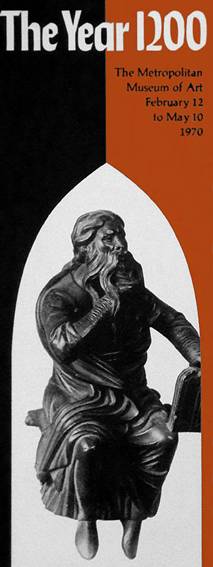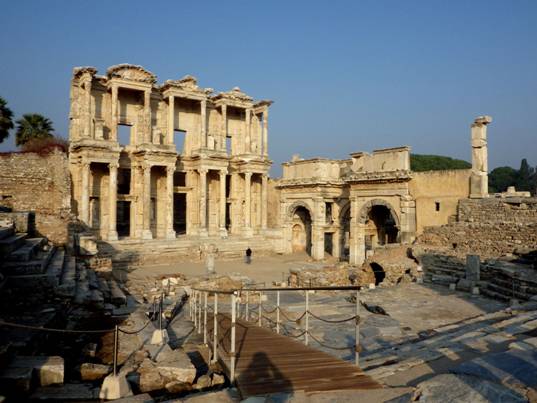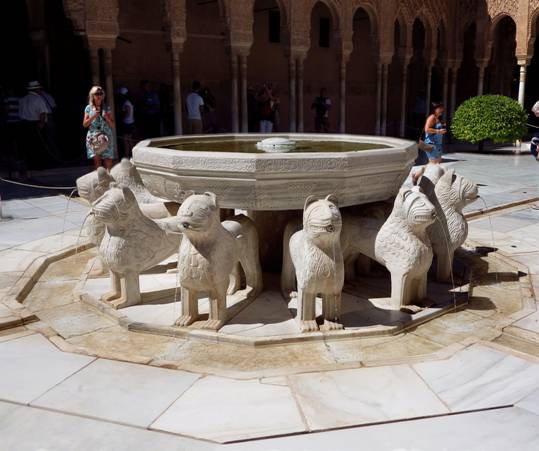O'Doherty Contemplative
Truth and Logic
Neil O'Doherty found the arguments put forth by Aristotle and Aquinas so elegant, clear, and persuasive that they illuminated the path he walked for as long as he lived. In the brief time in which I knew him, he concentrated more on what they said than on the history by which Aquinas came to know the works of a man born more than sixteen centuries before he was. Neil did say, however, that Aquinas came to understand Aristotle in part through the writings of Averroës and Avicenna, whom Neil described as Arabian philosophers. How did that happen?
*

Moses, Oxford, Ashmolean Museum
(Program for The Year 1200 Exhibition)
collection of Ronald A. Wencer
The Year 1200
Unexpectedly, I found the answer when I attended an exhibition - The Year 1200 - at the Metropolitan Museum of Art in 1970. On display were medieval objects from a number of the world's best collections. No matter where in Europe they originated, all the objects shared a new curvilinear style. Why?
Clues to the answer to both questions lie in the history of Europe in the twelfth century. After Islam took hold in the Middle East, Arabs carried it to many Mediterranean shores. In North Africa, the Moors - a conglomerate of many ethnicities, in which Arab seemed predominant - had grown strong. Crossing to the Iberian peninsula, they had established An-Andalus, a Muslim kingdom, in the year 711. It would endure for almost 800 years.
At times, An-Andalus was at war with nearby Christian nations, but at other times there was peace and tolerance. The decades that led to the year 1200 belonged to one of the latter periods, and during these years, educated European Christians and Andalusian Moors became more aware of each others' cultures, including art and architecture.
*
Learning Revived
The earlier collapse of the Roman Empire, including its network of ancient libraries, had cost Western Europe dearly. Monks and other Christian scholars had lost access to (among other things) the writings of the great ancient Greek thinkers. The Dark Ages soon earned their name.

Ruins of the Library of Celsus at Ephesus, third largest library
in the Roman Empire; it was destroyed in the third century,
likely by two events: Gothic invasion and earthquake
photograph by Ronald A. Wencer
As the centuries progressed into medieval times, the standard caricature of a Western scholar became that of a wanderer, who hoped against hope to someday find forgotten old manuscripts in some obscure place.
In the East, meanwhile, Islamic holy writings (including the Qur'an) told Muslims that Jews and Christians also had been favored by God, and that as People of the Book, they warranted respect. Parts of the Alhambra, the Moors' citadel in Granada, tangibly reflect that idea.

Courtyard in Muhammed V's Palace of the Lions in the Alhambra
Per the 'People of the Book' concept, each lion
in the fountain represents one Tribe of Israel
photograph by Ronald A. Wencer
Arabs, like the Romans, revered learning, and the writings that mattered to the other Peoples of the Book mattered to them as well. As Christian scholars in the West bewailed the loss of the ancient texts, Arab scholars were seeking the same texts in the East, finding them, studying them, and making faithful copies of them (usually in Arabic) in new centers of learning. The old network of Roman libraries was being supplanted by a new network of Arabic libraries.
*
Scholarly Toledo
By the eleventh century, the Iberian city of Toledo had become one of these centers of learning, crammed with educated people who were fluent in Greek, Roman, and Arabic. When the Moorish Empire was at peace with Europe, word of Toledo's wealth of knowledge, and especially its collection of ancient manuscripts, spread quickly. Given the Church's pent-up demand for ancient writings, Toledo's multi-lingual scholars were in high demand.
Below are the words of one twelfth century Canon (i.e., a member of a religious community which followed a code of conduct, often modeled on rules put in place by St. Augustine); he is known today simply as Canon Mark.

excerpt from The Arabic Impact on the Western World
by Marie-Thérèse d'Alverny
published in The Year 1200 II: A Background Survey
Canon Mark originally had wanted to study medicine, but he was so gifted with respect to languages that translation became his calling within the Church. Some years later, his Bishop would call upon him to translate the entire Qur'an into Latin, so that Catholic clerics could better understand Islam.
*
Aquinas: a More Complete Picture
It took nearly a hundred years to translate all of Aristotle's surviving works into Latin, and to create sufficient copies for the Christian monastic libraries. Sometimes, along with the Greek's own words, the manuscripts included scholarly commentary by Arabic thinkers - a cause of much study and debate among Catholic theologians. This period of debate - rarely face-to-face arguing, but instead exchanges of well-reasoned written ideas - was the time in which Aquinas lived, studying first in Naples and then in Paris. He had the great benefit of being able to read the original Metaphysics, and also the Muslim commentaries made on it by Avicenna (a Persian of the early eleventh century) and Averroës (an Islamic Spaniard of the twelfth century), in Latin, a language with which he was thoroughly familiar.
The giants of history are said to stand upon the shoulders of earlier giants, and Aquinas is often thought of as standing upon the shoulders of Aristotle. Fair enough. But Neil O'Doherty always made certain to also mention the Arabic commentators, men who in some ways lifted Aristotle's shoulders even higher for Aquinas. Think about that. Thomas Aquinas, whose thinking is fundamental to the Catholic Church, and who is considered a Saint, underpinned some of his metaphysical arguments with the ideas of a pagan philosopher, after first reading interpretations of them by Muslim scholars.
Imagine what it must have been like for Neil O'Doherty to first learn this tale. He never would have accepted the idea that Islam in any sense superseded Catholicism as a religion - yet he knew that an ancient Greek had been the first to lay bare an important kernel of truth, that Islamic philosophers had protected and nurtured that kernel, and that a Dominican monk had cultivated it further. This quest for truth had transcended people, beliefs, and cultures. Neil would have been gobsmacked.
***

